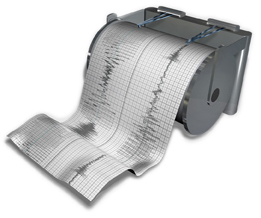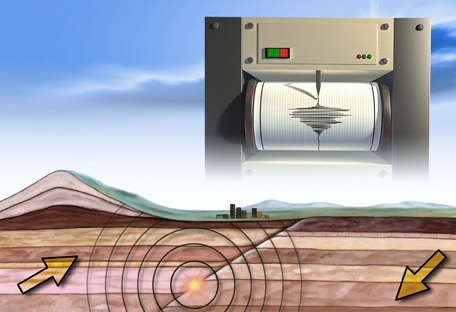Lesson 3
1. Lesson 3
1.1. Discover
Module 7: Exponents and Logarithms
Discover

iStockphoto/Thinkstock
The Richter scale, named after the American geologist Charles F. Richter, is used to measure the amount of energy released, or magnitude, of an earthquake. According to the Geological Survey of Canada, more than 4000 earthquakes occur in Canada every year, but only about 50 of these earthquakes are felt by humans.
Earthquakes are measured by magnitude and amplitude, where magnitude is a number on the Richter scale and amplitude refers to the vibrations caused by the earthquake. Knowing the value of one helps determine the value of the other. The function used to determine the magnitude of an earthquake is y = log x, where y is the magnitude and x is the amplitude of the vibrations, which are measured by a seismograph.

Hemera/Thinkstock
A seismograph (the device in the top right) is used to measure the amplitude of earthquake vibrations.
Try This 1
- Using the function y = log10 x, complete a table like the following using a calculator. On the calculator you will use the log x button (the log x button refers to log10 x).
Amplitude of Vibrations (x units) x Substituted into the Logarithmic Equation
y = log10 xRichter Scale Magnitude (y) x Written as a Power with Base 10 1 y = log10 1 0 
100 y = log10 100 
10 000 y = log10 10 000 1 000 000 y = log10 1 000 000 -
- Describe the relationship you see between x, written as a power with base 10, and the value of y.
- Based on the relationship determined in a., predict the solution to y = log10 100 000 000. Use the log button on your calculator to check your prediction.
- When using the Richter scale, doubling the magnitude does not correspond to a doubling of the amplitude. Consider the amplitude when the magnitude is 4 and 8. How much larger is the amplitude for an earthquake with a magnitude of 8 than an earthquake with a magnitude of 4?
Share 1
With a partner or group, discuss the following questions based on your solutions in Try This 1.
- Without using a calculator, how else could you determine the magnitude in the table of Try This 1? Describe the patterns you saw in Try This 1. Explain how exponents and logarithms are related based on this information.
- Discuss what you think the subscript 10 means in log10.
![]() If required, save a summary of your discussion in your course folder.
If required, save a summary of your discussion in your course folder.